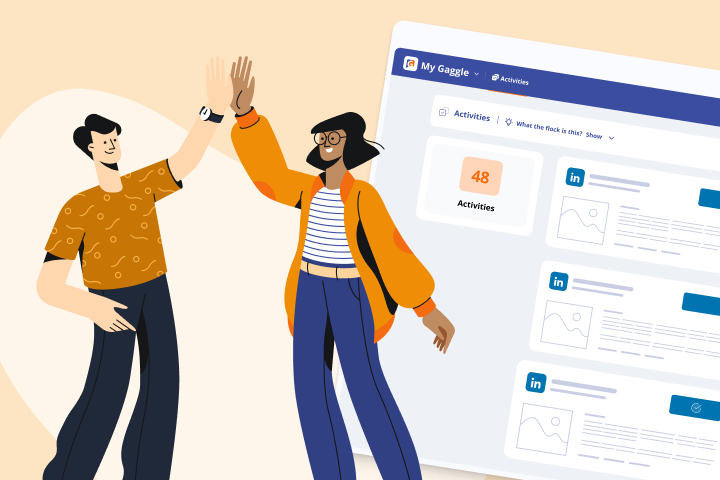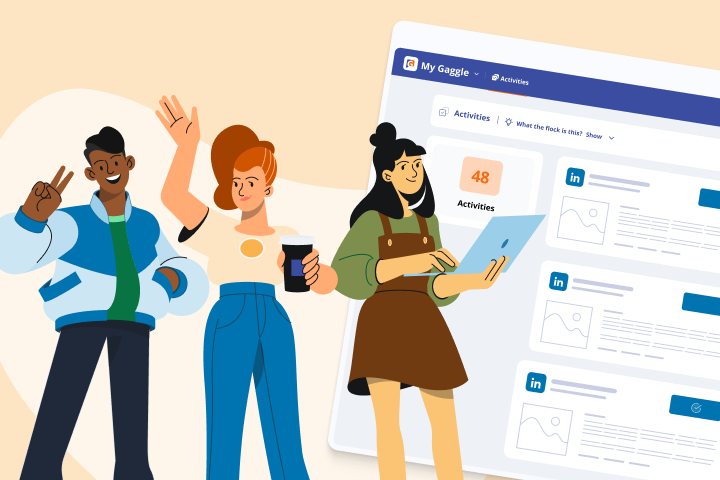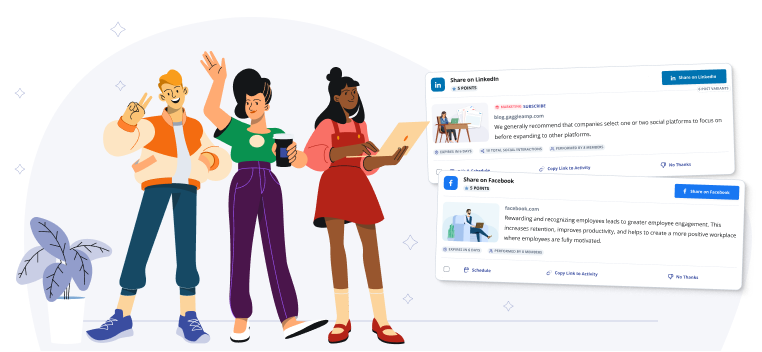How To Implement an Employee Recognition Strategy
Employee recognition is a foundational characteristic of highly effective teams and can directly impact a company’s bottom line.
However, building a culture of employee recognition can be tricky, as disingenuous praise can negatively affect the company culture and create voids between employees.
In addition, some team members may feel that employee recognition isn’t important to the company’s success, and you may struggle to get buy-in from the entire company.
In this post, we’ll explain the benefits of employee recognition, how to build a company culture around employee recognition, and a few easy yet meaningful employee recognition ideas.
What Is Employee Recognition?
Employee recognition is the act of publicly or privately acknowledging employees’ contributions to make them feel appreciated.
Employee recognition can range from simply thanking an employee in private for their effort on a project to sending a gift basket to an employee’s home to celebrate a new deal or partnership they helped facilitate.
The Benefits of Employee Recognition
Employee recognition is an easy way to improve employee satisfaction and boost morale, but more importantly, it can directly improve the company’s profitability.
Here are a few of the top benefits of implementing an effective employee recognition program.
Benefit #1: Higher Employee Retention
A study by Pew Research showed that 57% of American employees quit their jobs in 2021 because they felt disrespected at work.
The average cost to replace an employee is roughly one-half to two-times the employee’s annual salary. Making employees feel respected and appreciated at work can easily save the company thousands of dollars in recruiting costs.
Benefit #2: Improved Employee Performance and Productivity
If employees know that their hard work won't be appreciated or recognized, there's little incentive for them to go the extra mile. They'll also likely feel resentment toward the company.
While it's easy to argue that employees shouldn't need praise to deliver their best work, plenty of scientific evidence shows that praising employees is much more effective at improving performance than correcting their mistakes.
This is likely because people tend to feel more compelled to live up to a positive reputation than avoid negative consequences.
In addition, if managers frequently recognize their employees for their hard work, the employees will likely have better relationships with their managers, which will improve general communication.
If an issue arises during a project, employees with excellent managerial relationships are more likely to immediately reach out for help and get the project back on track. In contrast, employees with negative relationships with their managers might delay asking for help, which can delay the overall project.
Benefit #3: Attract Top Talent
Employee referrals are the most affordable talent acquisition method and tend to drive higher-quality candidates. 88% of employers rate employee referral programs as the best source of applicants.
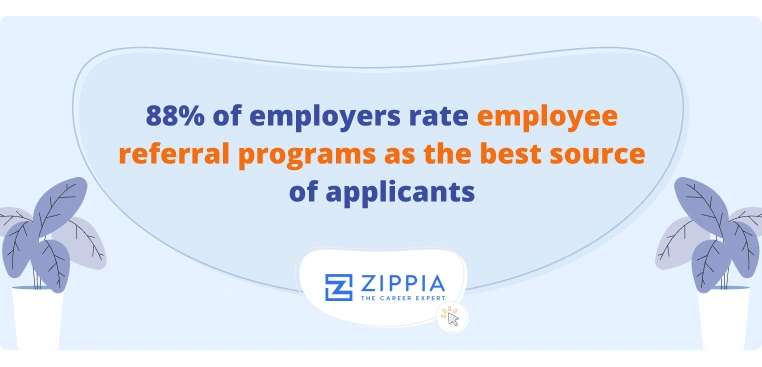
However, your employees will only refer their friends if they love working for your company and feel appreciated by their team members.
The good news is that once you’ve built a culture of appreciation and recognition, your employees will be more than happy to tell their friends about the company and even brag about it on social media. For example, this Crumbl Cookie employee felt appreciated and supported by her employer and responded by creating a thoughtful LinkedIn post about the company culture:
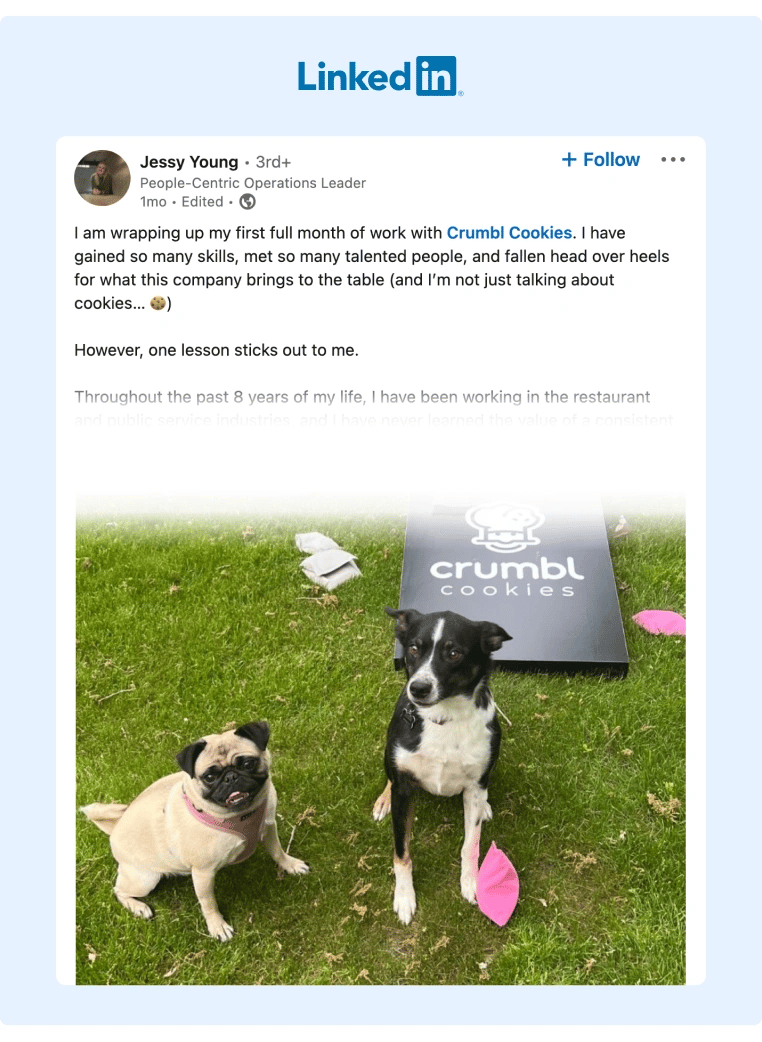
Employees that feel appreciated and recognized are also more likely to leave positive Glassdoor reviews and ratings, which can help convert talent for a new job opportunity.
Benefit #4: Reduce Wellness Costs
Offering paid-time-off (PTO), free healthy snacks, meditation/yoga classes, and other wellness initiatives are expensive for the company.
However, if you build a culture of recognition and employees are excited to go to work each day, they’re much less likely to need these wellness initiatives to stay motivated and happy.
In contrast, if employees feel burnt out due to a lack of appreciation, they’re much more likely to require these wellness initiatives and even therapy sessions, which cost the company more money.
How To Build a Company Culture of Employee Recognition
Building a culture of employee appreciation and recognition requires a strategic plan that involves getting buy-in across the company and giving employees the tools they need to show genuine appreciation to one another. Here's a four step plan you can use to build a culture that values employee recognition.
Step 1: Get Buy-In From Leadership
Employees follow the examples of their leaders, so successfully implementing any cultural changes, like employee recognition, requires buy-in from leadership.
Educate executives on the importance of employee recognition by showing them how it can improve the company's bottom line. You can build your argument using the benefits of employee recognition discussed above and even use real numbers, like the cost of employee turnover and absenteeism from the past year, to support your case.
Once you receive buy-in from executives, ask them to talk to managers and establish the importance of employee recognition.
Managers are more likely to oblige and implement employee recognition initiatives if the request comes directly from executives rather than HR.
When employees see their managers actively practicing employee recognition, they're more likely to show more formal recognition and appreciation to their co-workers, leading to a healthier workplace.
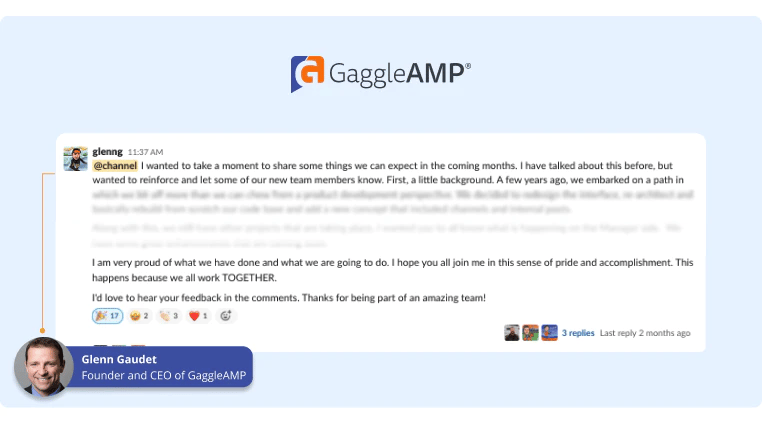
Step 2: Make Praise and Recognition Meaningful
Once you receive buy-in for your employee recognition program, give employees the tools to properly recognize their co-workers.
While teaching employees how to recognize one another may seem elementary, disingenuous shows of appreciation can actually make relationships worse.
For example, if a manager gives disproportionate praise to an employee for a minor accomplishment in front of their colleagues, it can embarrass the employee and make them feel alienated.
So, give senior leaders the following three guidelines to deliver effective praise:
-
Focus on a Meaningful Achievement: The most impactful compliments recognize an achievement the person cares deeply about and has put forth a lot of effort to attain. For example, complimenting someone for their outfit choice will be much less meaningful than complimenting them for achieving a promotion they've worked for all year.
-
Use Supporting Evidence: Compliments feel more genuine when they're supported by specific evidence. Instead of just stating, "The presentation was great!" state something more specific. For example, "I enjoyed your presentation and liked your tip on using ChatGPT to create contracts. I just sent my team an email to start implementing it in our workflow."
-
Make It Believable: Avoid exaggerating the compliment, it makes it seem more superficial and disingenuous. A pro tip is to avoid absolute language like "never," "always," and "every."
These three guidelines will help the praise seem more genuine and make team members feel truly appreciated.
Step 3: Implement Specific Recognition Initiatives
Verbal praise can go a long way, but there are also other ways you can demonstrate appreciation for employees. Offering performance-based bonuses and point-based reward programs for prizes (like an Amazon gift card or free massage) are two great examples.
The key to choosing the best employee rewards program is to ensure incentives align with company goals.
For example, offering a reward based on performance will positively impact the company's bottom line, whereas handing out rewards for things like birthdays that don't actually incentivize better performance is often a waste of the company's money.
That said, you can still certainly recognize employee birthdays and work anniversaries with a note or other low-cost celebration. These tokens of appreciation still make employees feel valued and increase company loyalty. However, save the company's recognition budget for rewards that praise employee achievement.
Step 4: Collect Feedback and Measure Success
When you begin encouraging employee recognition, it might feel forced, and your program will probably need to evolve.
This is normal, but to effectively improve your program, you'll need to collect feedback to know what to change.
Use employee surveys to measure current employee morale and ask them for open-ended feedback. You can also conduct quarterly one-on-one meetings with managers to learn how to improve the program.
Finally, track other business metrics, like sales and product shipment goals, as these are excellent for maintaining executive buy-in.
7 Easy Yet Meaningful Employee Recognition Ideas
Once you've built a strong company culture, you can incorporate other employee recognition ideas to enhance the employee experience and incentivize them to continue delivering great work. Here are a few of our favorite employee recognition ideas.
1. Send a Handwritten Note
You can always send your teammates kudos on Slack/Microsoft Teams or give them a thoughtful compliment in person. But handwritten notes have a more personal touch, and the receiver recognizes that they require a little more effort.
If you're not sure what to say inside the note, here are a few pointers to help you get started:
- What is something you're genuinely grateful to this person for, and why?
- What's a specific enjoyable/impactful experience you shared with this person?
- How has this person positively impacted your career and/or life?
You can also use this template to get started:
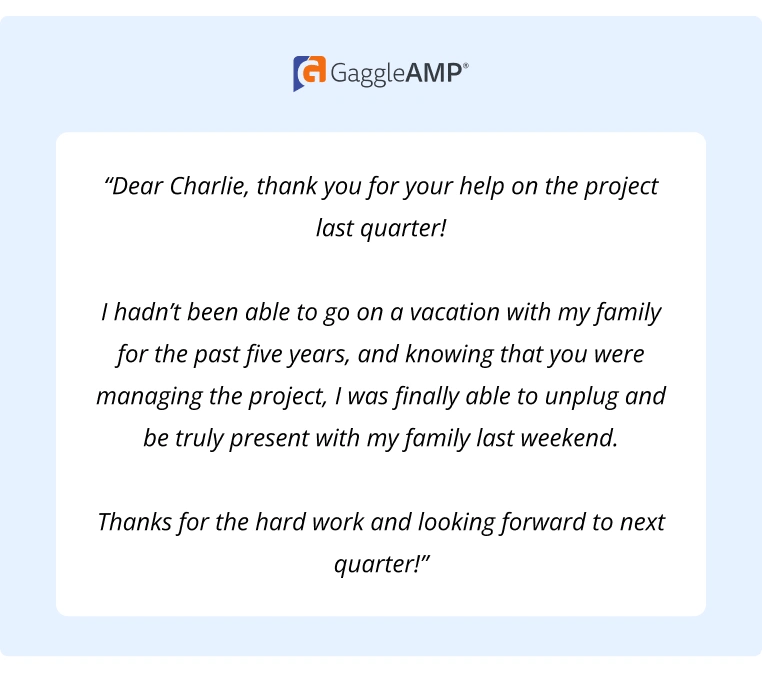
While you can make your note a few paragraphs, it can also be just a few sentences. The element of surprise is often what makes this handwritten note a successful tactic.
2. Give Shoutouts on Social Media
Privately thanking employees makes them feel appreciated, but giving them a public shoutout on social media is even more meaningful. It also makes them look great in front of their peers.
A public shoutout on social media is also helpful for employees seeking a promotion or other opportunities, like a speaker role at a conference.
Encourage both peers and managers to publicly recognize team members for noteworthy milestone achievements on social media.
Here's an excellent example of a meaningful peer-to-peer shoutout on social media:
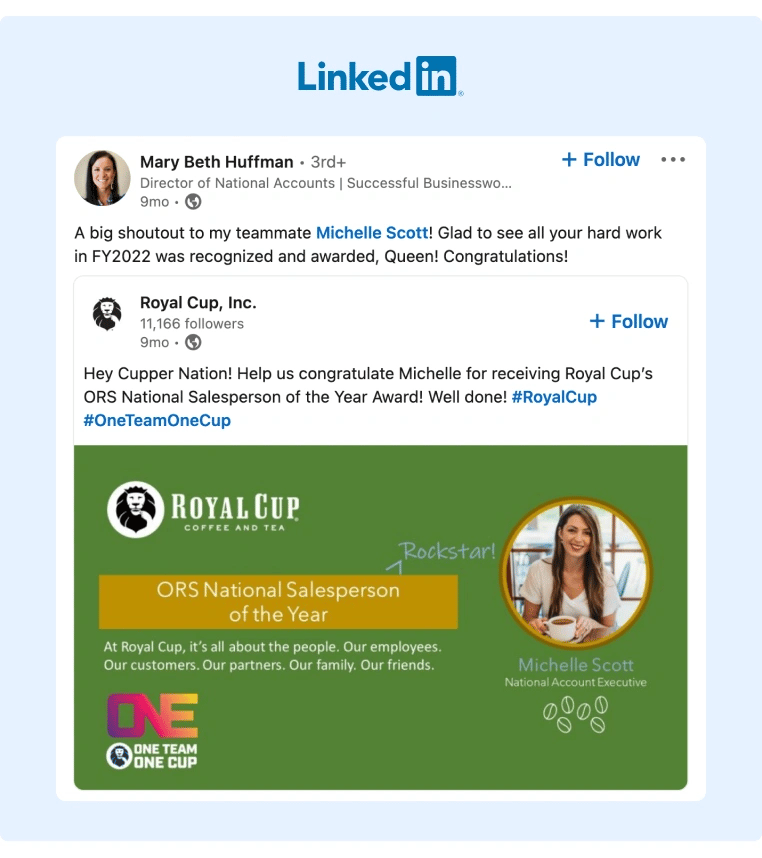
Source: Mary Beth Huffman
For this tip, follow the same guidelines outlined in step two by making the praise specific and genuine. These are also pretty simple call outs to add into your employee advocacy efforts.
3. Throw a Team Party
Throwing a virtual or in-person party for the highest-performing team is a great way to encourage teamwork and accomplish company goals.
For example, you might sponsor a team lunch or dinner once per quarter and award it to one team based on performance. During the quarter, you can use a point system that tracks small wins and key milestones, like deals closed or partnerships formed.
Then, award the party to the team with the most points at the end of the quarter.
Awarding the party to only one team (versus offering an entire company party) encourages friendly competition that inspires employees to work together to outperform other teams.
In addition, offering rewards based on performance rather than giving the party to a randomly selected team keeps employee incentives aligned with business outcomes.
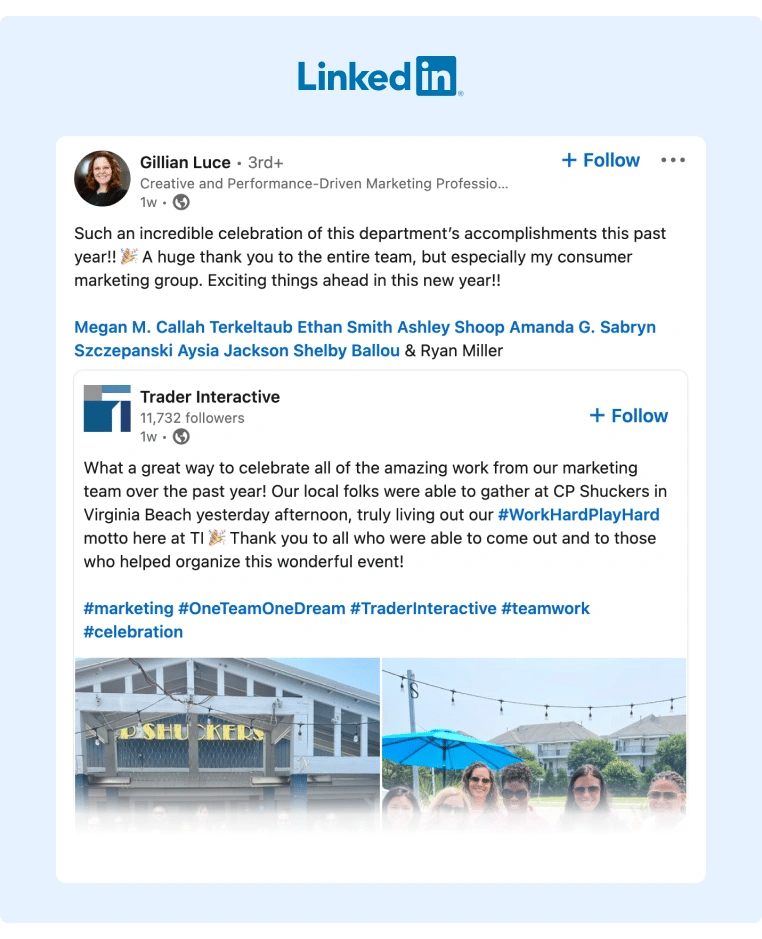
4. Give Company Swag
In the foundational steps, you worked with executives to ensure the company has a strong enough mission and vision that employees are excited about the future of the company and believe in its value.
If employees are proud to be part of the company, they'll likely value company swag, like a branded hoodie, t-shirt, or coffee mug. For example, this employee was thrilled when their swag box came in the mail:
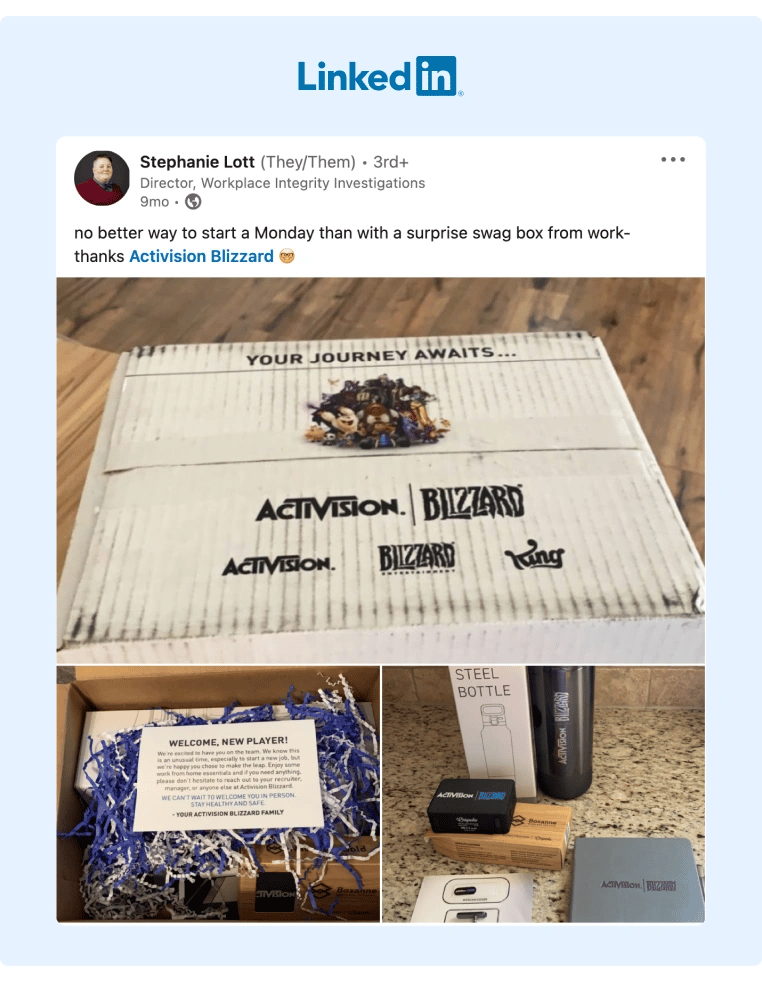
Source: Stephanie Lott
Company swag also doubles as additional brand promotion when employees wear it publicly.
You can use a vendor like Swag.com or Bandvia to create company swag and then award it to employees based on reward points tabulated in an employee recognition platform.
5. Offer Experiential Rewards
While sending gifts and prizes might make employees feel appreciated for a few moments, giving them an experience that can result in a lifetime of memories is much more meaningful and will make employees feel truly grateful to their employer.
For example, you can use a platform like Blueboard to award employees experience credits, and employees can redeem their rewards by selecting from various experiences, like skiing, parasailing, or ziplining.
You can also encourage employees to create social media posts about their adventures, which is a great way to promote the company culture and attract talent. Here's an excellent example of a company that sent its employee to Disneyland, and the employee happily posted about it on social media:

6. Call Out Employees’ Best Habits
When someone receives praise for a positive habit, they tend to work harder to maintain that reputation.
A great way to encourage employees to keep up their best habits is to give them public recognition for that habit.
This is a culture-building tactic that My First Million co-host, Shaan Puri, used when building the social media company Bebo.
He would take note of positive habits from various employees and then label that employee for that habit. For example, if he had a designer that frequently turned around projects quickly and was rarely late, he'd call out that person for always being on time, reliable, and dependable.
Then, each employee would work harder to maintain that reputation. In the example of the designer, that person would work harder to ensure they were always on time and submitted work quickly.
To execute this tip, think of a unique positive quality for each employee, write it down, and then host a party or event to publicly recognize each employee's best quality.
7. Offer Time-Off
Giving employees time off is an effective reward because it gives them a chance to rest and recharge, making them more productive at work.
In fact, if employees work non-stop for an extended period of time, they'll likely burn out over time and have to take time off to recharge anyway.
This is particularly true for top performers most worthy of recognition.
Instead of waiting for burnout to set in, which may cause their quality of work to suffer, providing time off is a great preventative measure to ensure employees feel appreciated and continue to deliver excellent performances.
Start Building Your Employee Recognition Program
All of the information above is what you need to create a complete employee recognition program, but take your time implementing it and expect to make adjustments along the way.
Changing an entire culture doesn't happen overnight, but start at step one and begin incorporating small examples of employee recognition today.
If you want an internal communication tool to further encourage peer recognition and employee engagement, consider using GaggleAMP. You can learn more about it on the product page or schedule a demo today.





